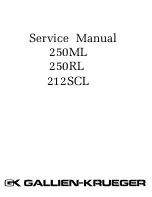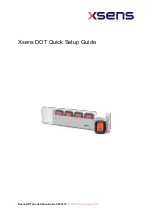
on the entry line. Any combination of commands and arguments that can be
generated by following the lines in the proper direction is syntactically
correct. An argument is optional if there is a path around it. When there is a
rectangle which contains the word "space," a white space character must be
entered. White space is optional in many other places.
Notation Conventions and Definitions
The following conventions are used in this manual when describing
programming rules and example.
< >
Angular brackets enclose words or characters that are used to symbolize a
program code parameter or a bus command
::=
"is defined as." For example, A ::= B indicates that A can be replaced by B in
any statement containing A.
|
"or." Indicates a choice of one element from a list. For example, A | B
indicates A or B, but not both.
...
An ellipsis (trailing dots) is used to indicate that the preceding element may
be repeated one or more times.
[ ]
Square brackets indicate that the enclosed items are optional.
{ }
When several items are enclosed by braces and separated by vertical bars (|),
one, and only one of these elements must be selected.
XXX
Three Xs after an ENTER or OUTPUT statement represent the device
address required by your controller.
<NL>
Linefeed (ASCII decimal 10).
Programming and Documentation Conventions
Notation Conventions and Definitions
5–5
Summary of Contents for 16501A LOGIC
Page 2: ...ii ...
Page 12: ...Contents 8 ...
Page 14: ......
Page 15: ...1 Introduction to Programming ...
Page 38: ...1 24 ...
Page 39: ...2 Programming Over HP IB ...
Page 45: ...3 Programming Over RS 232 C ...
Page 55: ...4 Programming Over LAN ...
Page 68: ...4 14 ...
Page 69: ...5 Programming and Documentation Conventions ...
Page 81: ...6 Message Communication and System Functions ...
Page 91: ...7 Status Reporting ...
Page 93: ...Figure 7 1 Status Byte Structures and Concepts Status Reporting 7 3 ...
Page 97: ...Figure 7 2 Service Request Enabling Status Reporting Key Features 7 7 ...
Page 100: ...Figure 7 3 Parallel Poll Data Structure Status Reporting Parallel Poll 7 10 ...
Page 105: ...8 Error Messages ...
Page 110: ...8 6 ...
Page 112: ......
Page 113: ...9 Common Commands ...
Page 116: ...Figure 9 1 Common Commands Syntax Diagram Common Commands 9 4 ...
Page 122: ...Figure 9 2 IST Data Structure Common Commands IST Individual Status 9 10 ...
Page 132: ...9 20 ...
Page 133: ...10 Mainframe Commands ...
Page 135: ...Figure 10 1 Mainframe Commands Syntax Diagram Mainframe Commands 10 3 ...
Page 136: ...Figure 10 1 continued Mainframe Commands Syntax Diagram continued Mainframe Commands 10 4 ...
Page 159: ...11 SYSTem Subsystem ...
Page 161: ...Figure 11 1 System Subsystem Commands Syntax Diagram SYSTem Subsystem 11 3 ...
Page 172: ...11 14 ...
Page 173: ...12 MMEMory Subsystem ...
Page 175: ...Figure 12 1 MMEMory Subsystem Commands Syntax Diagram MMEMory Subsystem 12 3 ...
Page 198: ...12 26 ...
Page 199: ...13 INTermodule Subsystem ...
Page 201: ...Figure 13 1 Intermodule Subsystem Commands Syntax Diagram INTermodule Subsystem 13 3 ...
Page 216: ...13 18 ...
Page 217: ...14 TGTctrl Subsystem ...
Page 219: ...Figure 14 1 Targetcontrol Subsystem Commands Syntax Diagram TGTctrl Subsystem 14 3 ...
Page 220: ...Figure 14 1 continued Targetcontrol Subsystem Commands Syntax Diagram TGTctrl Subsystem 14 4 ...
Page 233: ...Part 3 15 Programming Examples 15 1 Programming Examples ...
Page 234: ......
Page 235: ...15 Programming Examples ...
















































